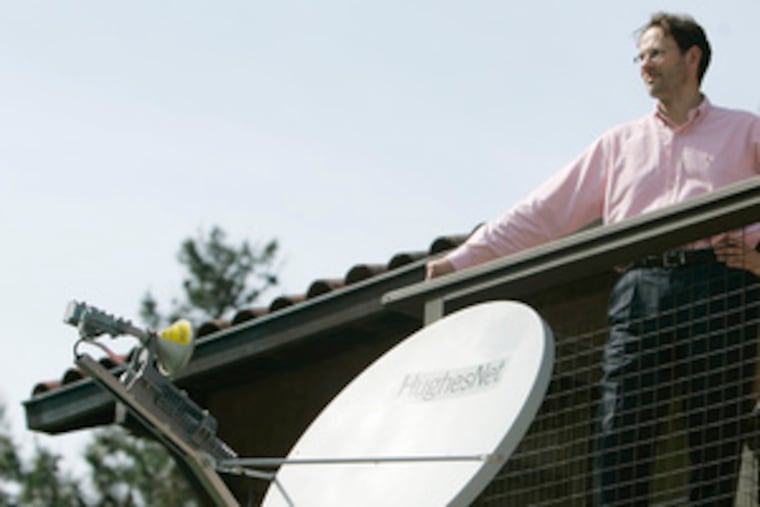
The Information Superhighway has bypassed Michael Schuppenhauer's ranch in an idyllic canyon near Half Moon Bay, Calif.
Schuppenhauer is too far from the local telephone hub for a digital subscriber line, or DSL. There is no cable. Even cell phones do not work, because of the rugged terrain. He could use dial-up, but that is too slow for much of today's Internet; handling large files such as online video is difficult.
So Schuppenhauer, a biotechnology consultant, gets broadband Internet service through a coffee-table-size satellite dish on the side of his house that sends his Google search requests on a 44,600-mile round trip into space.
Compared with cable or DSL, it is slow and expensive - $85 a month - but it allows Schuppenhauer to work full time from home.
"We have three horses and do competitive riding," he said. "We moved out here, and we're going to stay here."
Schuppenhauer has plenty of company. Satellites are the only broadband Internet choice available to as many as 10 percent of U.S. households, according to the largest provider of satellite broadband, Hughes Communications Inc.
"As people start realizing that there will be Internet haves and have-nots, they will be setting up satellite dishes," Schuppenhauer said.
HughesNet and its main competitor, WildBlue Communications Inc., are betting hundreds of millions of dollars that their lock on that market will last. They are more than doubling their capacity this year with two new satellites.
That is good news for second-homers, farmers, long-distance commuters, and others who are looking to get connected. However, the new satellites will do little or nothing to improve on the quality of service, which is handicapped by the capacity of the satellites and their distance from Earth.
Schuppenhauer calls his current HughesNet service "bearable." He tried WildBlue earlier, but had problems with slow uploads.
HughesNet, based in Germantown, Md., launched two-way satellite service for consumers and small businesses in 2001. It had 327,500 such subscribers in the United States at the end of last year and has been signing up 11,000 a month since then, according to marketing head Arunas Slekys.
HughesNet has been leasing capacity on a few different satellites, but in August, it will launch its own satellite, the Spaceway 3.
WildBlue, which is based in Greenwood Village, Colo., serves about 160,000 customers. It has been using spare bandwidth on a Canadian TV satellite, but in March, it turned on a new dedicated broadband satellite that will boost its potential total capacity to a million subscribers, according to chief executive officer Dave Leonard.
A third service, StarBand, has about 30,000 home and small-business satellite broadband subscribers in the United States. It is a subsidiary of Gilat Satellite Networks Ltd., an Israeli company.
Part of the problem with satellite Internet service is that the users are all competing for time on the satellite. When WildBlue service launched in 2005, the first users were often ecstatic about it because there were not so many as to slow one another down.
"It was really neat because everything just worked. I would really call it 'real broadband' back then," said Jeff Cashman, who uses the service to edit the Beaver Beacon monthly newspaper and to update Web sites from Beaver Island in Lake Michigan. The sandy island, a little more than two hours by ferry from Charlevoix, Mich., has about 600 permanent residents.
But WildBlue's satellite started filling up, and in November, the company changed the way it divided the satellite's capacity. The move allowed the satellite to accommodate more people, but slowed down response times. "That's when I stopped recommending it," Cashman said.
"If you look at this industry 10 years from now, there's still a good chance consumers will still be unhappy. And the reason is that satellite bandwidth is extremely expensive," said Randy Scott, manager at VSAT U.S., a Monument, Colo., company that installs satellite dishes for commercial customers. HughesNet is one of the companies he works with.
The new satellites, Scott said, could be used to improve the speed of the service, but the companies are choosing to increase capacity instead.
With its new satellite, WildBlue appears to be careful not to raise expectations the way it did with its first satellite in 2005, Scott said. People got used to the service and were disappointed as the satellite filled up and response times were throttled back.
"Guess what: They've learned their lesson," Scott said.
HughesNet has made enough capacity available "to keep the customer happy enough that they won't quit 'em," Scott said, "but not so happy that they're delighted."
Hughes CEO Pradman Kaul said, "Our goal is to provide all of our customers with a high-quality Internet experience which meets their requirements."
The other big limitation of using satellites is the speed of light: It takes at least half a second to send a signal like a Google search request to a satellite and get the results back. Because of congestion on the satellite, the time can run to three times that. That is not a big problem for Web surfing, but videoconferencing and online banking are hampered.
Cashman is hoping Beaver Island will leave the limitations behind with its own wireless data network, which so far covers only a portion of the island's main settlement, St. James.
Cellular broadband is stealing away some satellite users in other areas, but WildBlue and HughesNet believe that the expense of building out these networks means they will never reach everybody who wants them.